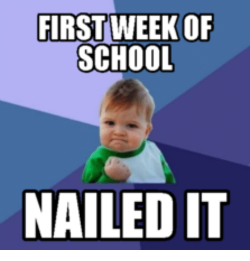Tip of the Week: Six Super Sweet Social Studies Strategies for Back to School
To help energize your first awesome week with kids, here are six great ways to kick off the school year.

It’s been an awesome week! Jump started it on Monday working with a small group of middle school and elementary teachers in the great state of Arizona. And am bookending it today and tomorrow with the fantastic staff at Rockdale County schools outside Atlanta. It doesn’t get much better than working with social studies folks who are passionate about their work.
And the super crazy thing?
They all start with kids next Monday. Next. Monday. As in, four days from today. Seriously? I would be so freaked out – worried about all the different things that need to get down to kick off the school year. But both groups have jumped in with both feet – learning new things, sharing their ideas, playing with tech tools.
But it got me thinking. Maybe you’re in the same boat, ready to shove off with kids already next week. If you are, this post is probably a few days too late. But I’m hoping that for most of you, you’ve got at least one or two more weekends before your first student contact day.
To help energize your first awesome week with kids, here are six great ways to kick off the school year. Use what you can. Adapt what you can’t.
What not to do
But before we get too far along with what we know works, it’s probably a good idea to think about what doesn’t. I’ve mentioned Fourteen Things You Should Never Do on the First Day of School before but it’s still a great reminder of what it looks like when we’re doing it wrong. Mark Barnes suggest that your goal should be a very simple one during the first few days of school:
Tools and ideas to transform education. Sign up below.
You have many days to assess students’ strengths and weaknesses. You have months to discuss high stakes testing and standards. You’ll spend weeks probing the textbook.
The first day of school should be dedicated to rapport-building and to joy.
Your goal should be that students go home that night and tell their parents: “I’m going to love history class because my teacher is awesome!”
So what should we be doing the first week?
Kids need to be in groups. They need to be solving problems. They need to get a taste of some social studies and play with some social studies tools. They need to know that it’s okay to fail. Find out more about them. They should practice a few critical thinking skills. Maybe a little tech here and there. Have fun.
Need some specifics? Start with these six:
1. Try a digital scavenger hunt
I love the idea of a #FlipHunt, even if I’ve never ran one with kids. Use Flipgrid to create a digital scavenger hunt. You create the Tasks to engage your students and challenge them to show what they know with video responses. Learn more about what this might look like from the #FlipHunt inventor, Kathi Kersznowski.
Not super comfortable with Flipgrid? Try the free Goose Chase app. Each GooseChase game has a list of missions for participants to complete. You can create your mission list using our bank of 100+ tested missions or by designing your own from scratch. Text & GPS missions are also possible.
2. Social Studies Boot Camp
Jill Weber teaches high school social studies in Maize, Kansas and is the 2016 Gilder Lehrman History of the Year. Several years ago, she decided to kick off her year teaching middle school by holding a week-long social studies Boot Camp that focused on historical thinking skills, types of evidence, problem solving, and collaborative learning.
She wrote a guest post that highlights all of her stuff, including handouts and lesson plans. You know you want to jump in on this cause . . . well, it’s awesome. Get all of the goodness here.

3. Geo Goodness
I love Google Earth and all of its bells and whistles. But the following activity is a great way to hook kids using just the basics of GE that is very simple to implement. Heck, you can use Google Maps if it makes things easier.
I call the activity “Where Are We?” and can be used to introduce a variety of history or geography units. Get the walkthrough here.
Then head over to this cool list of famous landmarks seen from different perspectives. Do a little bit of the same thing as with the Where Are We activity. This time kids have to guess what landmark we’re looking at. Require them to prove it using other photos that they scavenge from the interwebs. Feel free to have them do some extra research to create their own list.
Or check out Smarty Pins and Geoguessr. Both are fun, cool, and somewhat educational geo games. Making them perfect for the first week of school.
I have always been a huge fan of the this activity. Heck, we used it this week out in Arizona. Cause it works. Every time.
Go here to get info about the original version and the modified version. You’re welcome.

5. Memes
Give kids a bare bones scope and sequence of your content for the semester or year. Have kids pick one topic, person, event, or place from that scope and sequence. (Okay to work in groups of two? Absolutely.) Give them 10 minutes to become experts on that topic, person, event, or place.
Their task? Create a super hilarious and historically accurate meme and post it for contest viewing. Print them out (or use a tech tool such as Wakelet, Padlet, or Google Docs) and have kids arrange them chronologically, thematically, or heck . . . .by most super hilariousness.
Perfect for highlighting your content for the next few months. Gets kids up and doing. Solving problems. Cracking wise. Perfect first week activity.
Get some inspiration and specifics here.
6. Play with some art
Start by dividing your kids into groups of three. (Or two per group depending on your odds or evens.) Each group needs an internet friendly device. Direct them to the very fun site:
Quick Draw names an object or idea and asks you to draw it using a trackpad, stylus, or mouse depending on your device. (iPads or touch screens work best, just saying.) You have 20 seconds to draw it in such a way that another part of Quick Draw can guess what it is. (Trust me. It makes sense once you do it.) If you can’t draw the object in 20 seconds, it automatically jumps to the next one.
You’re given a total of six things to draw.
I’m sure you’re starting to see where this is going. You’ve got teams of kids. A contest. With tech. Let the fun begin.
Each group alternates drawing objects so everyone gets a chance to show off their artistic abilities. (Good luck drawing animal migration in 20 seconds. Just saying that came up in Arizona.) Maybe give them a practice round before you start eliminating kids.

The point to this is to get them thinking about art in the social studies. I especially love the idea of having kids create fan fiction versions of iconic paintings. Browse through this article about about recreating Norman Rockwell’s Four Freedoms. Then explore an extension of that idea at ForFreedoms. Have kids create their own versions of Rockwell’s work. Then dig into more art options here.
Explore these very cool Library of Congress interactive apps and tools.
Have a great first week of school!
cross posted at glennwiebe.org
Glenn Wiebe is an education and technology consultant with 15 years' experience teaching history and social studies. He is a curriculum consultant for ESSDACK, an educational service center in Hutchinson, Kansas, blogs frequently at History Tech and maintains Social Studies Central, a repository of resources targeted at K-12 educators. Visit glennwiebe.org to learn more about his speaking and presentation on education technology, innovative instruction and social studies.
